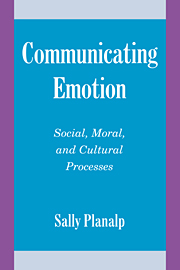Book contents
- Frontmatter
- Dedication
- Contents
- Acknowledgments
- Introduction
- 1 How Important Is Emotion in Everyday Interaction?
- 2 How and Why Is Emotion Communicated?
- 3 Is Emotional Communication Spontaneous or Strategic?
- 4 How Is Emotional Meaning Constructed Through Communication?
- 5 How Is Emotional Meaning Both Personal and Social?
- 6 How Do Emotion Messages Communicate Moral Meaning?
- 7 How Is Emotional Communication Grounded in Common Human Experience and Diverse Cultures?
- Epilogue: What is the Future of Emotional Meaning?
- References
- Author Index
- Subject Index
1 - How Important Is Emotion in Everyday Interaction?
Published online by Cambridge University Press: 05 February 2015
- Frontmatter
- Dedication
- Contents
- Acknowledgments
- Introduction
- 1 How Important Is Emotion in Everyday Interaction?
- 2 How and Why Is Emotion Communicated?
- 3 Is Emotional Communication Spontaneous or Strategic?
- 4 How Is Emotional Meaning Constructed Through Communication?
- 5 How Is Emotional Meaning Both Personal and Social?
- 6 How Do Emotion Messages Communicate Moral Meaning?
- 7 How Is Emotional Communication Grounded in Common Human Experience and Diverse Cultures?
- Epilogue: What is the Future of Emotional Meaning?
- References
- Author Index
- Subject Index
Summary
A world experienced without any affect would be a pallid, meaningless world. We would know that things happened, but we could not care whether they did or not.
Tomkins, (1979: 203)What role does emotion play in everyday talk? One view is this: You're having a perfectly normal conversation, and everything goes along just fine until some emotion disrupts things. You're talking about work with a friend and you happen to mention a sensitive topic (such as how he just lost his job), and he gets upset. He says something insulting to you (such as how you don't really deserve yours), and you have a hard time maintaining your composure. Another person enters the room and tells you that he has been offered a job (though one you know is not very good). He is thrilled. Talk to him? Forget it. There is no way you can carry on a rational conversation now. He is too emotional.
As Cochran and Claspell (1987: 2) say: “Emotion lurks about upsetting well-ordered lives, disrupting rationality, and dividing a person with paltry and degenerate demands.… An emotion is a commotion.” Most of the time we are free of emotion; it rarely occurs in everyday conversation, and blessedly so. When an emotion does occur such as when one person yells at another, someone “breaks down” in tears, or laughs “hysterically,” it is a BIG DEAL! “Tears are stupid, tears are childish, tears are a sign of weakness, important people don't cry, clever people don't cry” (Carmichael, 1991: 186). Normal patterns of interaction stop when emotion erupts, and everyone responds one way or another. We may confront the feelings, try to cope with them, or try to pretend that they didn't happen (as we do with many social disruptions). What we are unlikely to do, however, is to take the emotion into account and continue to talk, make decisions, and go about our business.
Yet there is another view of the role that emotion plays in everyday conversation. Emotion is what gives communication life. A conversation between emotionally involved partners is bright and lively, but a meeting without feeling is deadly dull.
- Type
- Chapter
- Information
- Communicating EmotionSocial, Moral, and Cultural Processes, pp. 9 - 38Publisher: Cambridge University PressPrint publication year: 1999
- 1
- Cited by

